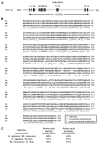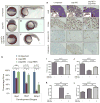Tumor suppressor Lzap regulates cell cycle progression, doming, and zebrafish epiboly
- PMID: 21523853
- PMCID: PMC3287344
- DOI: 10.1002/dvdy.22644
Tumor suppressor Lzap regulates cell cycle progression, doming, and zebrafish epiboly
Abstract
Initial stages of embryonic development rely on rapid, synchronized cell divisions of the fertilized egg followed by a set of morphogenetic movements collectively called epiboly and gastrulation. Lzap is a putative tumor suppressor whose expression is lost in 30% of head and neck squamous cell carcinomas. Lzap activities include regulation of cell cycle progression and response to therapeutic agents. Here, we explore developmental roles of the lzap gene during zebrafish morphogenesis. Lzap is highly conserved among vertebrates and is maternally deposited. Expression is initially ubiquitous during gastrulation, and later becomes more prominent in the pharyngeal arches, digestive tract, and brain. Antisense morpholino-mediated depletion of Lzap resulted in delayed cell divisions and apoptosis during blastomere formation, resulting in fewer, larger cells. Cell cycle analysis suggested that Lzap loss in early embryonic cells resulted in a G2/M arrest. Furthermore, the Lzap-deficient embryos failed to initiate epiboly--the earliest morphogenetic movement in animal development--which has been shown to be dependent on cell adhesion and migration of epithelial sheets. Our results strongly implicate Lzap in regulation of cell cycle progression, adhesion and migratory activity of epithelial cell sheets during early development. These functions provide further insight into Lzap activity that may contribute not only to development, but also to tumor formation.
Copyright © 2011 Wiley-Liss, Inc.
Figures





References
-
- Amon A. The spindle checkpoint. Curr Opin Genet Dev. 1999;9:69–75. - PubMed
-
- Arendt D, Nubler-Jung K. Rearranging gastrulation in the name of yolk: evolution of gastrulation in yolk-rich amniote eggs. Mech Dev. 1999;81:3–22. - PubMed
-
- Barrallo-Gimeno A, Holzschuh J, Driever W, Knapik EW. Neural crest survival and differentiation in zebrafish depends on mont blanc/tfap2a gene function. Development. 2004;131:1463–1477. - PubMed
Publication types
MeSH terms
Substances
Grants and funding
LinkOut - more resources
Full Text Sources
Molecular Biology Databases

